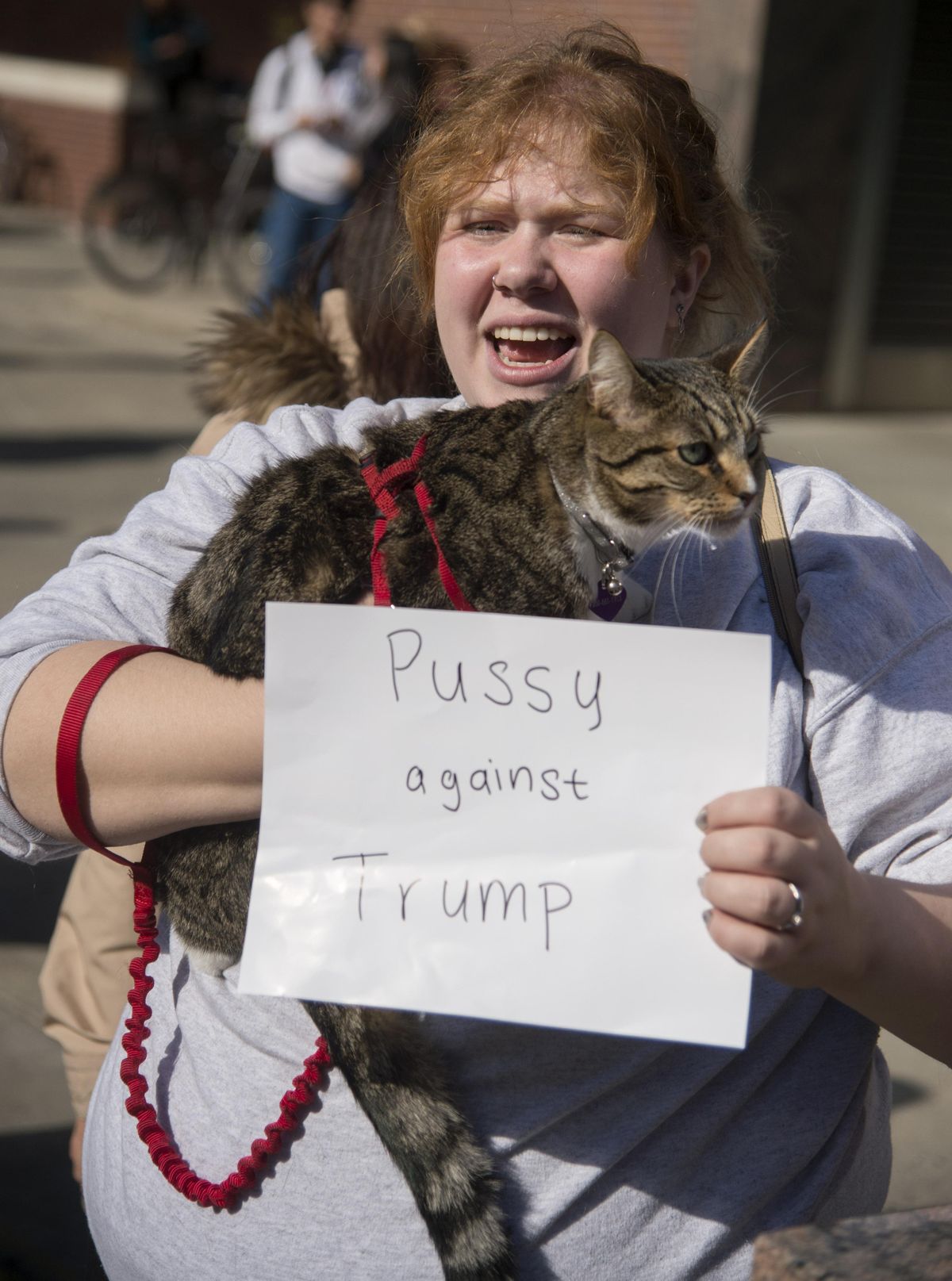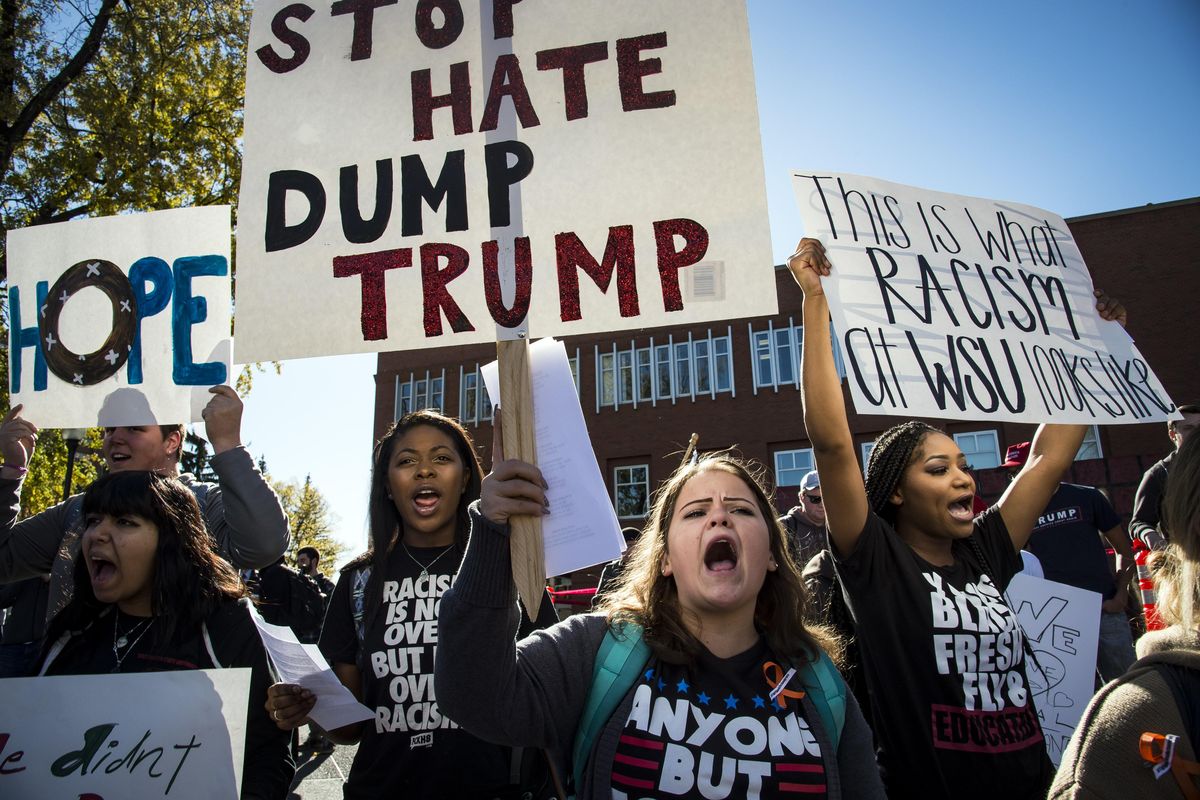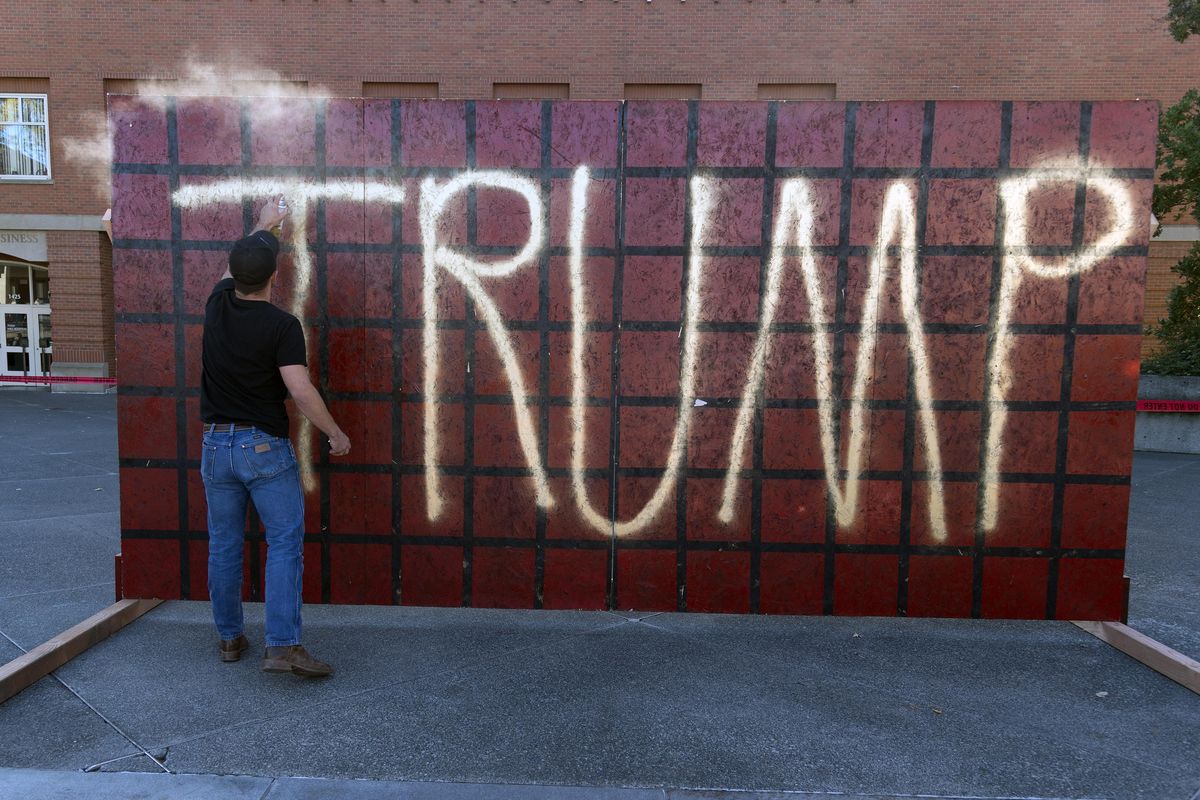‘Trump Wall’ on WSU campus draws hundreds of supporters and protesters
WSU student, Tosha Chavez, 21, center, protests the Trump Wall during the WSU College Republicans Trump Wall demonstration and Unity Rally counter protest Wed., on the WSU campus, Oct. 19, 2016, in Pullman, Wash. (Colin Mulvany / The Spokesman-Review)Buy a print of this photo
PULLMAN – Washington State University became a hotbed of political activism Wednesday when a small group of students erected a plywood wall in the center of campus to show support for Donald Trump and his proposal to build a wall along the country’s southern border.
The demonstration drew hundreds of protesters, mostly students, who spent hours chanting and toting signs to denounce the controversial Republican nominee. They criticized not only Trump’s immigration stance but also his comments about women, blacks, Hispanics, Muslims and Native Americans.
“I’ve been through four elections here, and I’ve never seen anything like this,” said Katy Fry, a history professor who started teaching at WSU in 2004. “I canceled my classes to encourage my students to come out and see the political process. I don’t care what side they’re on – I just want them to be observant and engaged.”
The wall went up shortly before 11 a.m. on the Glenn Terrell Friendship Mall and came down three hours later, as protesters shouted at the Trump supporters, “Take it down faster!” The wall was about 8 feet tall and 20 feet wide, painted to look like bricks and featured the word TRUMP written in a gold spray paint.
Many accused the Trump supporters of racism and xenophobia.
“They really don’t want Mexicans or diversity at WSU,” said Haley Delgado, a biology student whose parents emigrated from Mexico. “I had classes and meetings today, and all I could think about was this wall being built.”
The Friendship Mall quickly became a stage for countless topics of national discussion.
American Indian students held signs reading, “This land was stolen from us.” Others wore Black Lives Matter shirts, and one Trump supporter waved a Blue Lives Matter flag.
Some criticized a recently released tape in which Trump bragged about grabbing women’s genitals without their permission. A Libertarian student group brought a giant, inflatable ball they dubbed the “free speech ball,” on which students wrote political messages in black marker.
“No matter what you think about it, this election is crazy and it’s going to have a big impact on this country for a very long time,” said Drew McKeen, a women’s studies major. “I think a lot of people are trying to ignore it, so I’m glad they’re putting it right in front of our faces.”
Faculty members also joined the fray.
“I have a lot of immigrants in my class and I want to support them,” said Donna Potts, an English professor who held a sign and chanted with the crowd. “I think America’s already great and it’s great because of immigrants.”
Mark Dinges, an administrator in WSU’s College of Education, said he was appalled by the divisive rhetoric of the pro-Trump group.
“This is a great example of the white privilege that these Trump supporters enjoy,” Dinges said. “They stand on top of those stairs with no fear of reprisal. If a different group of people were up there, they would probably be told to stop complaining.”
Despite the protests and spirited debates, Trump supporters said the wall served its purpose.
“I think we may have changed some minds today,” said James Allsup, who spearheaded the wall effort. “I definitely think the silent majority is standing with us here.”
Allsup is the chairman of the Washington College Republican Federation and president of that group’s WSU chapter. In recent weeks, the College Republicans have been at odds with other WSU student groups, with insults flying on social media and in the student newspaper, the Daily Evergreen.
Allsup regularly writes about preserving “Western values.” In one guest column for the Evergreen, he wrote that Trump supporters “are tired of being called ‘racists’ for saying we need to build a border wall, or being told to kill ourselves for disagreeing politically with the left.”
The vitriol became so intense that the university issued statements reaffirming students’ speech rights and calling attention to programs and scholarships that support undocumented students. During the 2015-16 school year, 3,693 college students completed the Washington Application for State Financial Aid, which serves undocumented residents.
In an interview Tuesday, WSU President Kirk Schulz said undocumented students have “been a historic part of Washington State University. It’s nothing really new, but it’s important that we remind people that that’s part of our DNA as a land-grant institution.”
Schulz also said he hoped students would express their views in “a peaceful way.”
Voices were loud and emotions high, but no serious altercations were reported. One student apparently knocked a smartphone out of the hands of a Trump supporter, Fernando Reyes, who had been recording the demonstrations on Facebook Live. Reyes and others later shared the video, calling the incident an assault.
At least one student jumped over the wall in a show of defiance.
The Spokesman-Review
The Trump supporters generally maintained that they embrace legal immigration. Illegal immigration, they said, is bad for the U.S. economy. But they offered differing views on Trump’s promise to deport millions of undocumented immigrants already living in the country.
And they rejected accusations of racism.
“It’s not about the race or the culture,” said Reed Costello, a microbiology student from Dayton, Washington. “America is very culturally diverse. I accept that. I like that.”
Some said Trump’s comments about Mexicans have been taken out of context by the media. But Nate Hansberry, a Trump supporter studying international business, acknowledged that the candidate has said “some not-so-good stuff.”
Pro-Trump students erected a Trump wall at the University of Washington in May, sparking a response from UW President Ana Mari Cauce, who called it “offensive” and “contrary to the views of an inclusive, global campus.”
But Ken Nwadike thought Wednesday’s demonstrations were a healthy way to express conflicting views. He runs a campaign called the Free Hugs Project and has attended numerous political events across the country, including presidential rallies and a vigil for the police killed in the Dallas shootings.
“It’s unfortunate that they had to build a wall in order to get this to happen,” Nwadike said. But, “I think a lot of good came out of it, and there’s a lot of positive discussion. I think they all know and understand that they’re all students, and they have to work together. Unfortunately, you don’t see a lot of this outside of college campuses.”
A previous version of this story incorrectly stated the number of undocumented students served by Washington State University during the 2015-16 school year. The figure provided actually represents the total number of college students who completed the Washington Application for State Financial Aid, which serves undocumented residents – not just WSU students. The number was incorrect due to a source’s error.














